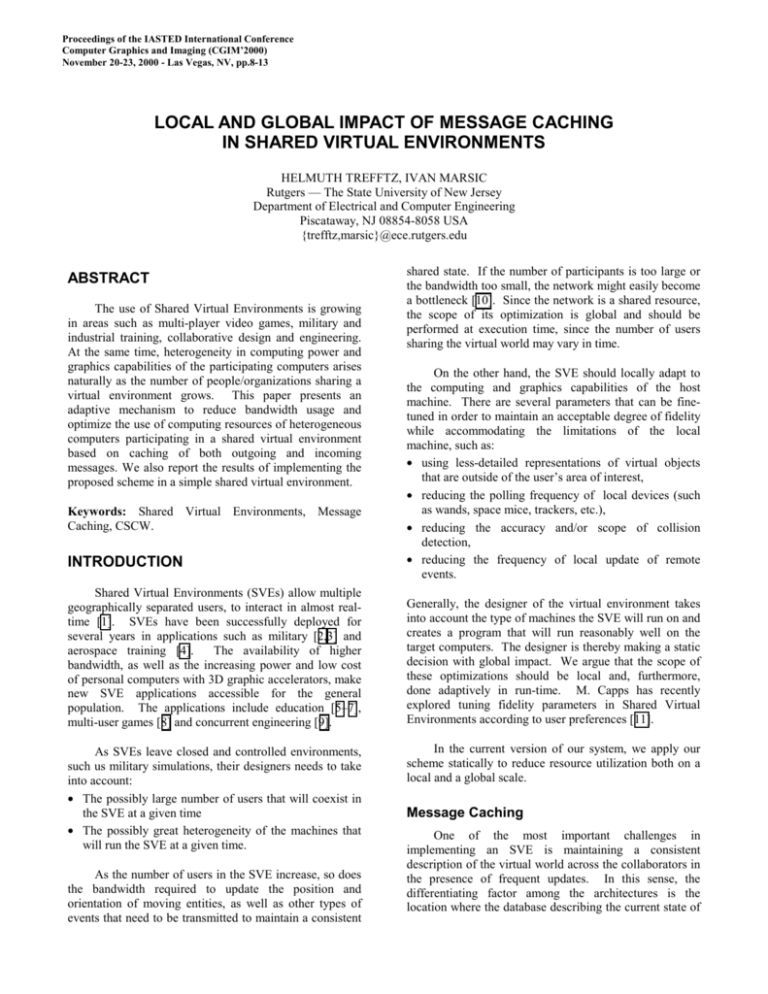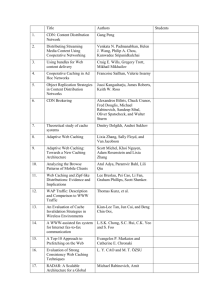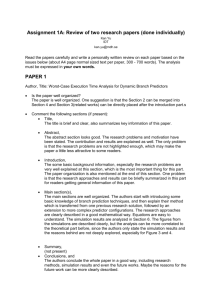Local and Global Impact of Message Caching in Shared Virtual
advertisement

Proceedings of the IASTED International Conference
Computer Graphics and Imaging (CGIM’2000)
November 20-23, 2000 - Las Vegas, NV, pp.8-13
LOCAL AND GLOBAL IMPACT OF MESSAGE CACHING
IN SHARED VIRTUAL ENVIRONMENTS
HELMUTH TREFFTZ, IVAN MARSIC
Rutgers — The State University of New Jersey
Department of Electrical and Computer Engineering
Piscataway, NJ 08854-8058 USA
{trefftz,marsic}@ece.rutgers.edu
ABSTRACT
The use of Shared Virtual Environments is growing
in areas such as multi-player video games, military and
industrial training, collaborative design and engineering.
At the same time, heterogeneity in computing power and
graphics capabilities of the participating computers arises
naturally as the number of people/organizations sharing a
virtual environment grows. This paper presents an
adaptive mechanism to reduce bandwidth usage and
optimize the use of computing resources of heterogeneous
computers participating in a shared virtual environment
based on caching of both outgoing and incoming
messages. We also report the results of implementing the
proposed scheme in a simple shared virtual environment.
Keywords: Shared Virtual Environments, Message
Caching, CSCW.
INTRODUCTION
Shared Virtual Environments (SVEs) allow multiple
geographically separated users, to interact in almost realtime [1]. SVEs have been successfully deployed for
several years in applications such as military [2,3] and
aerospace training [4].
The availability of higher
bandwidth, as well as the increasing power and low cost
of personal computers with 3D graphic accelerators, make
new SVE applications accessible for the general
population. The applications include education [5–7],
multi-user games [8] and concurrent engineering [9].
As SVEs leave closed and controlled environments,
such us military simulations, their designers needs to take
into account:
• The possibly large number of users that will coexist in
the SVE at a given time
• The possibly great heterogeneity of the machines that
will run the SVE at a given time.
As the number of users in the SVE increase, so does
the bandwidth required to update the position and
orientation of moving entities, as well as other types of
events that need to be transmitted to maintain a consistent
shared state. If the number of participants is too large or
the bandwidth too small, the network might easily become
a bottleneck [10]. Since the network is a shared resource,
the scope of its optimization is global and should be
performed at execution time, since the number of users
sharing the virtual world may vary in time.
On the other hand, the SVE should locally adapt to
the computing and graphics capabilities of the host
machine. There are several parameters that can be finetuned in order to maintain an acceptable degree of fidelity
while accommodating the limitations of the local
machine, such as:
• using less-detailed representations of virtual objects
that are outside of the user’s area of interest,
• reducing the polling frequency of local devices (such
as wands, space mice, trackers, etc.),
• reducing the accuracy and/or scope of collision
detection,
• reducing the frequency of local update of remote
events.
Generally, the designer of the virtual environment takes
into account the type of machines the SVE will run on and
creates a program that will run reasonably well on the
target computers. The designer is thereby making a static
decision with global impact. We argue that the scope of
these optimizations should be local and, furthermore,
done adaptively in run-time. M. Capps has recently
explored tuning fidelity parameters in Shared Virtual
Environments according to user preferences [11].
In the current version of our system, we apply our
scheme statically to reduce resource utilization both on a
local and a global scale.
Message Caching
One of the most important challenges in
implementing an SVE is maintaining a consistent
description of the virtual world across the collaborators in
the presence of frequent updates. In this sense, the
differentiating factor among the architectures is the
location where the database describing the current state of
the virtual world is maintained. On one end of the
spectrum are the centralized systems, in which the
description of the virtual world is kept on a server. The
server broadcasts the virtual world updates to the clients.
On the other end are the replicated or peer-to-peer
architectures, in which the status of the virtual world is
kept on every participating site. Each node is responsible
for keeping the local copy consistent and up-to-date. We
have taken the latter approach for the system described in
this paper. There are numerous combinations in between
these two extremes, such as systems that assign a “home
node” to each entity. In this case, the state of the entity is
maintained in the home node only.
The challenge of maintaining a consistent
description of the virtual world is similar to many
problems in distributed systems, such as the problem of
consistency in distributed databases or the cachecoherence problem in multi-processor machines; and
designers of SVEs can apply similar solutions.
Aggregation of messages is described in [10] as a
technique to reduce bandwidth utilization by grouping
together sets of packets sent to the network. Bandwidth
saving takes place since only one header is used for the
whole group. Singhal reports that the aggregation can be
done according to time (sending the update whenever a
pre-defined timeout expires) or to packet number (sending
the update whenever a certain number of packets be
ready).
The message caching scheme presented here is
different in several ways as will be detailed later. The
general architecture of our system is described in
Figure 1. The program was written mostly in Java and
Java3D [14], except for the driver of the Space Mouse,
which was written in C. The main components of the
system are:
•
Scene Graph: The data structure that contains the
current state of the shared world. The display thread
(Java3D) reads this data structure and renders the
scene from the user’s virtual viewpoint.
•
Local Devices: Drivers for the local devices used for
interaction in the virtual world.
•
Local Events Cache (LEC): Cache for locally
generated events. An entry is kept in the outgoingmessages-cache for every entity that has been
modified locally. Local updates are displayed and
reflected in this cache as soon as they occur, but they
are not sent to the network immediately. Instead, an
outgoing-time-out (OT) is defined and the updates
are sent when the time-out expires. In the meantime,
new updates to a local entity overwrite any older
update to the same entity existing in the Local Events
Cache.
Scene
Local
devices
Graph
Synch
Remote Events
Cache
Local Events
Cache
Network
Figure 1: Architecture of the system.
•
Remote Events Cache (REC): Cache for remotely
generated events. An entry is kept for every remotely
modified entity. Again, remote updates are not
displayed immediately. Instead, an incoming-timeout (IT) is defined and the updates are reflected in the
local scene when the time-out expires. In the
meantime, a new update to a remote entity overwrites
any older update to the same entity existing in the
IMC.
•
Synch: Object that guarantees mutually exclusive
access to the Scene Graph.
Our approach is different from the one described in
[12] in the following essential ways:
• Our scheme handles not only out-going messages but
also in-coming ones.
• We propose not only grouping the messages but also
sending only the latest update for each modified
entity. Our scheme behaves more like a cache.
The global and local impacts of the OMC and the
IMC are explained next.
Caching of Outgoing Messages
Caching the local updates before sending them to the
network has a global impact on the use of the network.
Most of the time, users in a SVE are either moving in the
world or manipulating an object. In both cases, the
updates will be cached in the LEC and, depending on the
value of the OT, the number of updates sent to the
network will be reduced considerably. A larger value of
OT will avoid having a fast machine flooding the network
and the slower machines with too frequent updates.
The frame rate (number of times the scene is
rendered in the local computer per unit of time) is
important when determining the value of OT and IT. The
frame rate of the fastest machine defines a lower
boundary for OT. Sending updates more frequently than
the fastest machine can display them would be a waste of
resources. Defining OT as the reciprocal of the frame rate
of the slowest machine would make the updates
unnecessarily slow for everybody else. For this reason we
decide to define OT as the reciprocal of the median frame
rate among the participating machines.
OT = median {(1/FRI), I: for all participating nodes}
where FRI is the Frame Rate of node I.
Caching of Incoming Messages
Caching the remote updates before updating the
scene locally has a local impact. The local data structure
describing the Virtual World becomes a critical shared
resource that can be updated by either local or remote
events in order to avoid inconsistencies. Caching remote
updates favors local updates, in which the user is probably
more interested.
Slower nodes use caching of incoming messages to
further reduce the flooding effect of frequent updates
generated by faster machines. Messages are received and
stored in the local cache, but the scene is not necessarily
updated immediately. Participating computers with a
faster frame rate than the reciprocal of OT do not need to
slow down the rate of remote updates, but slower
computers do, in order to favor local updates. For this
reason we are using the following formula for IT:
IT = max {(1 / FR) × (N + 1), OT}
where FR is the Frame Rate of the node and N is a factor
related to the importance of local events relative to remote
events.
In a system that polls the devices once per frame, if
N is 1, IT will tend to accommodate for 1 local event for
every remote event; if N is 2, IT will accommodate for 2
local events for every remote event, and so on. In a
system that has separate threads for handling events and
for rendering, N+1 will simply indicate how many frames
will elapse, in average, before the local scene is updated
with in-coming events.
Caching and Global vs. Local Optimization
Caching outgoing events reduces the bandwidth
usage, since the number of messages sent by unit of time
is reduced. The impact is especially meaningful when the
participating nodes share a segment or a local area
network or when the bandwidth is a scarce resource.
Caching outgoing events also reduce the time other nodes
will use to process remote events. Obviously the time-out
values which determine the caching must be chosen
judiciously: if the outgoing-time-out is too large the
Figure 2: Typical display of the Shared Virtual
Environment.
remote events will look jumpy1, if it is too small there will
be no benefit.
Caching incoming messages, on the other hand, has
only a local effect. If computing resources are scarce, in
most applications it is best to give priority to updates
generated from local events, since they will most likely be
of most importance for the local user.
EXPERIMENTAL SETUP
In order to evaluate the effects of our messagecaching scheme, we implemented a simple virtual
environment that allows users to furnish an office in a
collaborative manner. Most interactions are accomplished
by manipulating a Logitech 3D-mouse [13]. Figure 2
shows a typical display during the process of arranging
the furniture of the virtual office. Three computers were
used for the experiments as shown in Table 1.
Table 1: Experimental setup.
Computer
Processor(s)
BOCHICA
Dual Pentium
III 700 MHz
Pentium II 400
MHz
Pentium II 350
MHz
MORLAK
DRAGONFIRE
Memory
Graphics
Card
1
FireGL
Gigabyte
1000
256
CirrusLogic
Megabytes GCD 54
32
Diamond
Megabytes SpeedStar
The computers were connected to a 100 Mbps local
area network. All participating nodes shared a multicast
group to send and receive updates from the peers.
1
Introducing dead reckoning could alleviate the
jumpiness. If dead reckoning is used, though, the remote
events will appear delayed.
Table 2: Experiment trials.
2 Nodes
3 Nodes
No
Caching
Trial 1
Trial 4
OT = IT
= 250 ms
Trial 2
Trial 5
OT = IT
= 500 ms
Trial 3
Trial 6
RESULTS
We observed a positive impact of our scheme in the
following areas:
•
•
•
Reduced bandwidth requirement.
Increased frequency of local updates
Increased frame rate.
The impact is explained in the following sections.
Reduced Bandwidth
As mentioned before, the effect of caching out-going
messages is reducing the amount of utilized bandwidth.
This rather evident fact is shown in Figure 3, which
describes the number of messages sent by all participating
computers during the trials. The number of messages is
larger for trials 4, 5 and 6 since three computers are
running, instead of two.
Local Updates
In the presence of caching, the user actions are
reflected faster on the local scene graph, as described in
Figure 4. Locally generated updates are given priority
Number of messages
Number of messages sent
4000
3500
3000
2500
2000
1500
1000
500
0
1
2
3
4
5
6
Trial
Figure 3: Total number of messages sent during each
trial.
Local Update Period
Period (ms)
The experiment consists of the following tasks:
Setup time: The program is started in every
participating computer. An object is inserted and selected
for manipulation on each computer.
Stage 1 (0 – 20 secs.): Recording of the different
times starts. No manipulation takes place. The Frame
Rate baseline is obtained.
Stage 2 (20 – 40 secs.): The locally selected object
is manipulated at the slowest machine only (Dragonfire).
Stage 3 (40 – 60 secs.): A selected object is
manipulated at each machine, generating events as
frequently as each computer allows.
Stage 4 (60 – 80 secs.): Manipulation stops at all
nodes. At the end of this stage recording finishes.
At each computer the current time (in milliseconds)
was saved for each of the following events:
• Each displayed frame.
• Each update of the Scene Graph with a local event.
• Each update of the Scene Graph with a remote event.
• Each message sent to the multicast group.
The experiment trials were arranged according to
Table 2.
80
70
60
50
40
30
20
10
0
1
2
3
4
5
6
Trial
Figure 4: Average local Update Period in
milliseconds for Dragonfire. Period reduces as the
caching time-out values increase.
over remotely generated events as the caching time-out
times increase.
Note that the local Update Period is considerably
smaller than the Frame Period for Dragonfire, the slowest
computer in the setup. In our system, local devices are
handled by a separate thread, instead of being polled once
per frame. This allows for more frequent generation of
events. From a local perspective, this is a waste of
resources, but it allows faster computers sharing the same
environment to receive more frequent updates.
Frame Rate
The frame rate of slower machines is affected
adversely as the number of remote events increases.
Caching reduces the negative impact, bringing the frame
rate closer to the baseline level, as described in Table 3
and Figure 5. Table 3 shows the average frame rate
period for Dragonfire during each stage and Figure 5
shows the percentage increment of stages 2 (only local
updates) and 3 (local and remote updates), relative to
stage 1 (baseline).
In trials 1, 2 and 3, two nodes were participating, in
trials 4, 5 and 6 three nodes were participating. It is easy
to see the trend towards larger frame rate periods as the
number of nodes increase. The most dramatic increment
is 20%, when three nodes take part of the environment
without message caching.
25
20
15
Stage 1
Stage 2
%
On the other hand, the impact of the remote events is
reduced as the caching time-out values grow from 0 ms
(tasks 1 and 4) to 250 ms (task 2 and 5) and to 500 ms
(task 3 and 6).
Increment in Frame Update Period
Stage 3
10
5
Table 3: Average Frame Rate Period in milliseconds.
Caching reduces the flooding impact of remote events.
0
1
Trial
1
2
3
4
5
6
Stage 1
1042
1197
1125
1170
953
1111
Stage 2
1133
1252
1160
1255
1032
1160
Stage 3
1174
1294
1165
1415
1023
1180
2
3
4
5
6
Trial
Figure 5: Percentage increment of Frame Rate Period.
The flooding impact of remote events (stage 3) is
reduced by larger caching time-out values.
ACKNOWLEDGMENTS
CONCLUSIONS AND FUTURE WORK
We have implemented a message-caching scheme
that can be used, in run time, to perform global and local
optimization of resource utilization.
Our initial
experiments show the positive impact on several critical
factors of SVEs, most interestingly bandwidth
requirements and display frame rate.
For this initial set of experiments, the incoming and
outgoing message time-out values were statically and
globally defined. In the near future we will actually
implement the dynamic computation of these parameters,
during runtime, based on the Frame Rate of each node.
Future Work: Our main interest is to enable effective
collaboration in Shared Virtual Environments even when
the participating computers have varying degrees of
computing power. We plan to devise similar schemes to
work with other parameters such as level-of-detail and
frequency to poll local devices, always with the objective
of optimizing both local and global usage of resources in
run-time.
Further information about the Rutgers University
DISCIPLE project is available at:
http://www.caip.rutgers.edu/disciple/
The research reported here is supported in part by
NSF KDI Contract No. IIS-98-72995, DARPA Contract
No. N66001-96-C-8510 and by the Rutgers Center for
Advanced Information Processing (CAIP).
REFERENCES
[1] S. Singhal and M. Zyda.
Networked Virtual
Environments. (New York: Addison-Wesley, 1999).
[2] D. Cohen. DIS—Back to basics. Proceedings of the
11th Workshop on Standards for Distributed
Interactive Simulations, pp.603-617, September
1994.
[3] NPSNET Web Site:
http://www.npsnet.nps.navy.mil/npsnet
[4] R.B. Loftin and P. Kenney. The use of virtual
environments for training the Hubble space telescope
flight team. Available online at:
http://metropolis.vetl.uh.edu/Hubble/virtel.html
[5] V. Pantelidis and L. Auld. VR in the schools.
Available online at:
http://www.soe.ecu.edu/vr/pub.htm
[6] M. Roussos, A.Janson, J. Leigh, C. Barnes, C.
Vasilakis, and T. Moher, The NICE project:
Narrative, immersive, constructionist/collaborative
environments for learning in virtual reality,
Proceedings of ED-MEDIA/ED-TELECOM 97,
Calgary, Canada, pp.917-922, June 1997.
[7] Trefftz H., C. Correa, M. A. Gonzalez, J. Restrepo, C.
Trefftz. Virtual reality and distance learning in
Colombia, IASTED International Conference on
Computer Graphics and Imaging, Halifax, Nova
Scotia, Canada, June 1998.
[8] idSoftware Web site: http://www.idsoftware.com
[9] K. Hartung, S. Muench, L. Schomaker, T. GuiardMarigny, B. Le Goff, R. MacLaverty, J. Nijtmans, A.
Camurri, I. Defee and C. Benoit. Development of a
system architecture for the acquisition, integration
and representation of multimodal information,
Deliverable 4, ESPRIT Project 8579 – MIAMI, 1996.
[10] S. Singhal. Using projection aggregations to support
scalability in distributed simulation. Proceedings of
the IEEE International Conference on Distributed
Computing Systems (ICDCS’96), Hong Kong, 1996.
[11] M. Capps. Fidelity optimization in distributed virtual
environments.
PhD thesis, Naval Postgraduate
School, Monterey, CA, June 2000.
[12] S. Singhal and M. Zyda. Networked Virtual
Environments. pp.191-195, (New York: AddisonWesley, 1999).
[13]
Magellan / Space Mouse User’s Manual.
LogiCad3D GmbH, a Logitech company. Gilching,
Germany, 1999.
[14] H. Sowizral, K. Rushforth, M. Deering. The Java 3D
API Specification. 2nd Ed, (New York: AddisonWesley, 2000).





